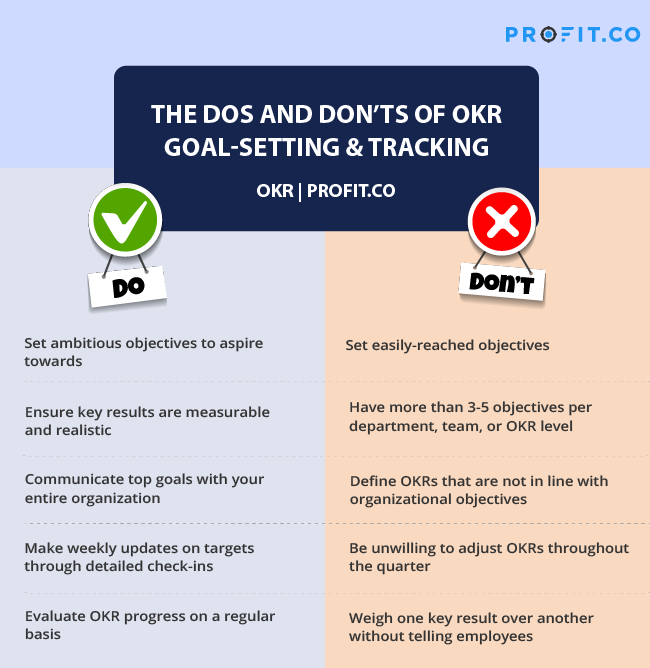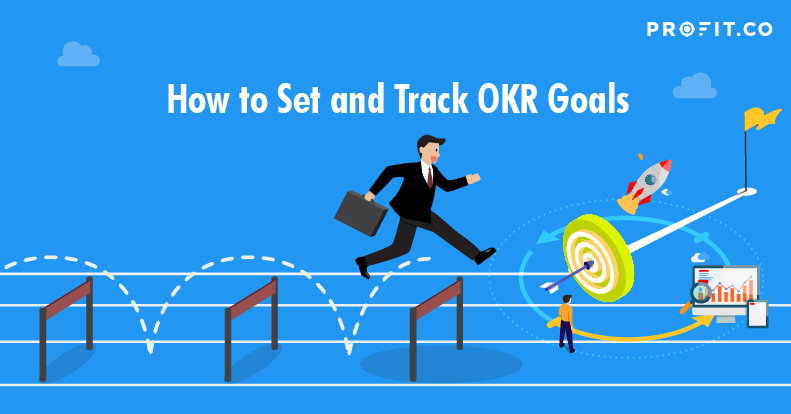An organization is more than just a hierarchy of departments and teams. An organization is defined by the common goals it is working towards. Without those core values to guide a company, employees won’t have a sense of purpose, or clarity on what matters most for the organization.
Even when you go after a more ambitious goal, even if you fail to achieve that one, all the side effects that come along the way can be that much more rewarding and significant in their own right
The organization may have hundreds of employees, even thousands. Each individual is different and has his or her own priorities in the organization, such as professional growth. So, organizing individuals with different priorities and making everyone work towards the goals of the organization is a massive undertaking that cannot happen without frameworks and systems that are purpose-built for goal setting.

Objectives and Key Results (OKR) is one of the most popular and proven frameworks for goal setting, aligning employees to goals and getting the most out of them.
OKR for goal setting
There are numerous goal setting frameworks to get work done and reach the goals effectively and efficiently, such as Management By Objectives (MBO), SMART goals, Key Performance Indicators (KPI), and many more. Each framework has its advantages and disadvantages. OKR offers some compelling reasons for you to adopt it as the goal setting framework. Following are some of the reasons why using OKR for goal setting is the ideal choice for your organization.
Benefits of OKR for goal setting:
- OKR helps in goal setting for performance, as it encourages employees to set ambitious goals and find ways to achieve them.
- OKR helps set short-term goals strictly in line with the long-term objectives of the organization. This creates focus towards the long-term growth of the organization.
- OKR goal setting enables everyone in the organization to see what others are proposing to do in order to meet the objectives. This gives clarity of purpose as well as a benchmark for employees to pursue.
- OKR goal setting not only involves deciding what to achieve, but also how to achieve them. So, the employees have a clear sense of direction right from the beginning.
- OKR goal setting is a process that inspires and motivates the employees. Every time there is a new benchmark for achievement, the employees set goals higher than that to achieve more.
Want to discuss how your organization can use OKRs on Profit.co’s OKR Management software? Book a free demo with our OKR experts today!
Ready to start your OKR Journey for FREE?
Setting OKR goals
The purpose of OKR goal-setting exercise is to:
- Create alignment of purpose and expectations amongst the employees
- Set ambitious medium-term objectives in line with the long-term goals of the organization
- Break the objectives into short-term key results
- Distribute them amongst the teams and
- Let teams work out an action plan to achieve them
These OKR goals should be flexible. They should be specific, measurable, achievable, relevant and time-bound. In short, they should be SMART:
Specific: OKR goals should clearly define what you want to achieve exactly. They can be quantitative, such as a sales target.
Measurable: They should be numerically measurable. For example, the sales channel will give you the exact weekly sales number.
Achievable: While the medium-term objectives can be ambitious, the key results/goals should be challenging, but still achievable.
Relevant: Key results should be aligned to the objectives. Only then they can be relevant to your purpose.
Time-bound: There should be a deadline for any goal.
For example, if the quarterly objective of the organization is to achieve 2X sales compared to last quarter, the SMART goals can be:
- Reach 1000 new prospective customers through an online ad campaign in this week
- Increase the weekly sales figure of the product by 100 more units in 10 days.
As you can see, SMART goals can serve as key results that will help you accurately measure your goals.
Tracking OKR goals
By its very nature, OKR demands constant review of the progress towards the objectives of the teams and the organization. So the employees set short-term targets, report on the progress every week and review their achievement every week. Through these constant reviews, the organization can track the following:
- Achievements of teams as well as the overall achievement of the organization in relation to the objectives and long-term goals
- Capabilities of the employees based on what they deliver consistently.
- Reasons for failures and the snags the employees hit in their work.
- Solutions for the identified problems and challenges with OKR strategy execution.
- Innovative methods that were identified in the course of trying to achieve a major milestone.
- Means to implement innovations and replicate success stories from the teams throughout the organization.
- Individual contributions to the team.
The greatest strength of the OKR goal-setting framework is the ability to consolidate these learnings and feedback from weekly reviews, make an action plan based on them, and implement changes quickly to achieve better performance and results immediately.
In addition to short-term reviews you can also conduct an in-depth review at the end of the review period. In this review, the performance can be scored and graded, and the percentage of achievement towards the overall achievements can be tracked.

OKR goal setting and tracking: Dos and Don’ts
Following are some of the dos and don’ts in goal setting that can bring you the best results when using Objectives and Key Results.
1. Set your objectives high and unachievable
The objectives can be highly ambitious, and the employee does not have to achieve 100% of the key result. He or she just needs to put in 100% effort in trying to achieve them so that they will overachieve even if they fail.
2. Don’t set objectives that are too easy to achieve
If the objectives are 100% completed, it probably means you did not aim high enough. Set objectives higher such that even 70% completion of the same is considered as a success.
3. Don’t set more than three to five objectives
Setting too many objectives can take the focus off the employees, and they will need to spend their energy on so many things. In the end, they won’t be able to achieve enough of any objective.
4. Set the expected outcomes, namely key results, and define the means to measure them
Key Results should always be measurable. Without relevant numbers, it becomes impossible to prove what you have achieved. Set three to five measurable key results for every objective you had set.
5. Don’t set OKRs that are not in line with the organizational objectives
If your objectives and key results are not aligned to the organization’s goals, then the efforts taken by the workforce will not aggregate into the growth and success you want for the organization.
6. Clearly communicate goals to your employees
Communicating the goals with your team is a key process that helps align the entire organization towards the goals.
7. Update the achievements every week
OKR works by breaking down the goals into smaller targets. As a result, they need to be tracked often to check the progress. So, updating them at individual level and constantly reviewing the team progress is indispensable.
8. Do not keep OKRs rigid
Objectives and Key Results can be flexible. Since the overall objectives are ambitious, the means to achieve them may change, as individuals and teams use their creativity to find workarounds to overcome challenges. New methods can be identified and challenges can be solved mid-way through. Depending on those developments, if the employees need to scale up or scale down their deliverables and change their goals accordingly, it has to be allowed.
9. Evaluate the progress often
Constant review helps you track progress towards goals at team and organizational level. If there is lack of alignment to goals, it can be identified and employees can be quickly realigned. If there are learnings, they can be fed as inputs next time when you have to set short-term goals.
10. Do not weigh one key result over another without telling employees
The achievement towards an objective must be calculated based on the average score of all the key results connected to the particular objective. All the key results must be given equal weightage, unless you and your team decide that one is more important than the other.
Ready to achieve your OKR goals with an agile and intuitive software that you can roll out to your entire team? Get started on Profit.co today for free and find out what the right OKR software can do for you!
Ready to start your OKR Journey for FREE?

